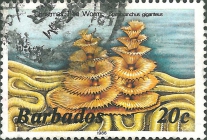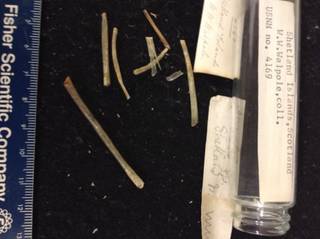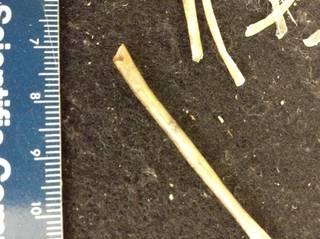
| About | | Search taxa | | Taxon tree | | Search literature | | Specimens | | Distribution | | Checklist | | Stats | | Log in |
WoRMS taxon detailsSpirobranchus giganteus (Pallas, 1766)
209944 (urn:lsid:marinespecies.org:taxname:209944)
accepted
Species
Cymospira bicornis (Abildgaard, 1789) · unaccepted (superseded subsequent...)
superseded subsequent recombination of subjective synonym Cymospira cervina Quatrefages, 1866 · unaccepted (subjective synonym)
Cymospira gigantea (Pallas, 1766) · unaccepted
Cymospira megasoma Quatrefages, 1866 · unaccepted (subjective synonym)
Cymospira rubus Quatrefages, 1866 · unaccepted
Olga elegantissima Jones, 1962 · unaccepted (subjective synonym)
Penicillum marinum Seba, 1758 · unaccepted (pre Linnaean name)
Pomatoceros oerstedi Voss & Voss, 1955 · unaccepted (nomen nudum, subjective synonym)
Serpula (Cymospira) gigantea Pallas, 1766 · unaccepted (superseded subgenus combination)
Serpula (Galeolaria) gigantea (Pallas, 1776) · unaccepted (superseded recombination)
Serpula bicornis (Abildgaard, 1789) · unaccepted (subjective synonym)
Serpula gigantea Pallas, 1766 · unaccepted (synonym)
Spirobranchus (Cymospira) giganteus (Pallas, 1776) · unaccepted (superseded subgenus recombination)
Spirobranchus giganteus giganteus (Pallas, 1766) · unaccepted > superseded combination (superseded recombination with...)
superseded recombination with abandoned subspecies rank Spirobranchus giganteus microceras Mörch, 1863 · unaccepted (subjective synonym)
Spirobranchus giganteus tricornis Mörch, 1863 · unaccepted (subjective synonym)
Spirobranchus megasoma (Quatrefages, 1866) · unaccepted
Spirobranchus tricornis Mörch, 1863 · unaccepted (superseded recombination of...)
superseded recombination of subjective synonym Terebella bicornis Abildgaard, 1789 · unaccepted (subjective synonym)
marine,
recent only
(of Serpula gigantea Pallas, 1766) Pallas, P.S. (1766) Miscellanea zoologica. Quibus novae imprimis atque obscurae animalium species describuntur et observationibus iconibusque illustrantur. Petrum van Cleef. Hagí Comitum., xii + 224 pp.;14 pls., available online at https://archive.org/details/pspallasmedicina00pall
page(s): 139; note: Serpula gigantea (in large font) is title of a section, beginning p.139 [details]
Type locality contained in Caribbean Sea
type locality contained in Caribbean Sea [from synonym] [view taxon] [details]
Read, G.; Fauchald, K. (Ed.) (2025). World Polychaeta Database. Spirobranchus giganteus (Pallas, 1766). Accessed through: World Register of Marine Species at: https://www.marinespecies.org/aphia.php?p=taxdetails&id=209944 on 2025-07-16
Date action by
Nomenclatureoriginal description
(of Serpula gigantea Pallas, 1766) Pallas, P.S. (1766) Miscellanea zoologica. Quibus novae imprimis atque obscurae animalium species describuntur et observationibus iconibusque illustrantur. Petrum van Cleef. Hagí Comitum., xii + 224 pp.;14 pls., available online at https://archive.org/details/pspallasmedicina00pall page(s): 139; note: Serpula gigantea (in large font) is title of a section, beginning p.139 [details] original description (of Cymospira rubus Quatrefages, 1866) Quatrefages, A. de. (1866 (1865)). Histoire naturelle des Annelés marins et d'eau douce. Annélides et Géphyriens. <em>Librarie Encyclopédique de Roret. Paris.</em> <b>Volume 1.</b> 1-588., available online at http://books.google.com/books?id=FV9IAAAAYAAJ page(s): p.542 [details] original description (of Olga elegantissima Jones, 1962) Jones, Meredith L. (1962). On some polychaetous annelids from Jamaica, the West Indies. <em>Bulletin of the American Museum of Natural History.</em> 124(5): 169-212, plate 52., available online at http://hdl.handle.net/2246/1213 page(s): 202-204, text-figs. 125-128, plate 52 figs. 1-2 [details] Available for editors original description (of Spirobranchus giganteus microceras Mörch, 1863) Mörch [Mørch], O. A. L. (1863). Revisio critica Serpulidarum. Et Bidrag til Rørormenes Naturhistorie. <em>Naturhistorisk Tidsskrift København.</em> Ser. 3, 1: 347-470, pl. 11 [also issued as a separate, 1–124, pl. 11]., available online at http://www.archive.org/details/naturhistoriskti01copeuoft page(s): 404 [details] original description (of Spirobranchus giganteus tricornis Mörch, 1863) Mörch [Mørch], O. A. L. (1863). Revisio critica Serpulidarum. Et Bidrag til Rørormenes Naturhistorie. <em>Naturhistorisk Tidsskrift København.</em> Ser. 3, 1: 347-470, pl. 11 [also issued as a separate, 1–124, pl. 11]., available online at http://www.archive.org/details/naturhistoriskti01copeuoft page(s): 404; note: originally described as 'var. B. tricornis' of Spirobranchus giganteus [details] original description (of Cymospira cervina Quatrefages, 1866) Quatrefages, A. de. (1866 (1865)). Histoire naturelle des Annelés marins et d'eau douce. Annélides et Géphyriens. <em>Librarie Encyclopédique de Roret. Paris.</em> <b>Volume 1.</b> 1-588., available online at http://books.google.com/books?id=FV9IAAAAYAAJ page(s): p.544 [details] original description (of Cymospira megasoma Quatrefages, 1866) Quatrefages, A. de. (1866 (1865)). Histoire naturelle des Annelés marins et d'eau douce. Annélides et Géphyriens. <em>Librarie Encyclopédique de Roret. Paris.</em> <b>Volume 1.</b> 1-588., available online at http://books.google.com/books?id=FV9IAAAAYAAJ page(s): p.541 [details] original description (of Terebella bicornis Abildgaard, 1789) Abildgaard, P.C. (1789). Beschreibung 1. einer grossen Seeblase (Holothuria priapus Linn.) 2. zween Arten des Steinbohrers (Terebella Linn.) 3.einer grossen Sandroehre (Sabella Linn.). <em>Schriften der Berlinischen Gesellschaft Naturforschender Freunde.</em> 9: 133-146, plates 3-4., available online at http://ds.ub.uni-bielefeld.de/viewer/!toc/1923584_012/36/LOG_0006/ page(s): 142, plate 3 fig. 4 [details] original description (of Penicillum marinum Seba, 1758) Seba, A. (1734-1765). Locupletissimi rerum naturalium thesauri accurata descriptio, et iconibus artificiosissimis expressio, per universam physiees historiam : Opus, cui, in hoc rerum genere, nullum par exstitit / Description exacte des principales curiosités naturelles du magnifique cabinet d'Albert Seba. 4 vols (v1 1734, v2 1735, v3 1759, v4 1765), Amstelaedami :Apud Janssonio-Waesbergios & J. Wetstenium & Gul. Smith., available online at http://www.biodiversitylibrary.org/bibliography/62760 page(s): 39, plate XVI figure 7 [volume 3] [details] basis of record Day, J. H. (1967). [Sedentaria] A monograph on the Polychaeta of Southern Africa. Part 2. Sedentaria. British Museum (Natural History), London. pp. 459–842., available online at http://www.biodiversitylibrary.org/bibliography/8596 [details] Taxonomysource of synonymy
Hartman, Olga. (1959). Catalogue of the Polychaetous Annelids of the World. Parts 1 and 2. <em>Allan Hancock Foundation Occasional Paper.</em> 23: 1-628. [details] Available for editors redescription ten Hove, Harry A. (1970). Serpulinae (Polychaeta) from the Caribbean: I - The genus <i>Spirobranchus</i>. <em>Studies on the Fauna of Curaçao and other Caribbean Islands.</em> 32: 1-57, plates I-V., available online at https://repository.naturalis.nl/pub/506140 [details] Available for editors Othercontext source (HKRMS)
Lam KKY. (2003). Epibenthic community development on an experimental pulverised ful ash (PFA) artifical reef. In: Morton B, editor. Asian Marine Biology 18.Hong Kong University Press, Hong Kong. pp 71-90. [details]
additional source Streftaris, N., A. Zenetos & E. Papathanassiou. (2005). Globalisation in marine ecosystems: the story of non-indigenous marine species across European seas. <em>Oceanogry and Marine Biology: an Annual Review.</em> 43: 419-453. (look up in IMIS) [details] Available for editors additional source Ehlers, E. (1887). Reports on the results of dredging, under the direction of L. F. Pourtalès, during the years 1868-1870, and of Alexander Agassiz, in the Gulf of Mexico (1877-78), and in the Caribbean Sea (1878-79), in the U.S. Coast Survey steamer "Blake", Lieut-Com. C. D. Sigsbee, U.S.N. and Commander J. R. Bartlett, U.S.N., commanding. XXXI. Report on the Annelids. <em>Memoirs of the Museum of Comparative Zoology at Harvard College.</em> 15: vi & 335 pp., available online at https://www.biodiversitylibrary.org/page/30734338 page(s): 286-292, plate 57 figs. 1-7 [details] additional source Fauvel, P. (1933). Annélides polychètes du Golfe du Pei Tcheu Ly de la collection du Musée Hoang ho Pai ho. Récoltées par le R.P. Leroy, S.J. et le R.P. Licent S.J. <em>Publications du Musée Hoang ho Pai ho de Tien Tsin.</em> 15: 1-67. page(s): 62 [details] additional source Straughan, Dale. (1967). Marine Serpulidae (Annelida: Polychaeta) of eastern Queensland and New South Wales. <em>Australian Journal of Zoology.</em> 15(1): 201-261., available online at http://www.publish.csiro.au/?paper=ZO9670201 page(s): 245-246, fig. 14e [details] Available for editors additional source Fauchald, K.; Granados-Barba, A.; Solís-Weiss, V. (2009). Polychaeta (Annelida) of the Gulf of Mexico, Pp. 751–788 in D.L. Felder and D.K. Camp (eds.). <em>Gulf of Mexico. Origin, Waters, and Biota. Volume 1, Biodiversity.</em> Texas A&M University Press, College Station, Texas., available online at https://books.google.es/books?id=CphA8hiwaFIC&lpg=PR1&pg=PA751 [details] additional source Liu, J.Y. [Ruiyu] (ed.). (2008). Checklist of marine biota of China seas. <em>China Science Press.</em> 1267 pp. (look up in IMIS) [details] Available for editors biology source Smith, Richard Stewart. (1985). Photoreceptors of serpulid polychaetes. <em>[thesis].</em> pp. 1-424, Ph.D. thesis James Cook University, Queensland, Australia., available online at http://eprints.jcu.edu.au/24188 note: Possibly this worm studied was Spirobranchus tetraceros, as the location was Australia [details] biology source Smith, Richard. (1984). Development and settling of Spirobranchus giganteus (Polychaeta; Serpulidae),. <em>[Book chapter].</em> p. 461-483 In Proceedings of the First International Polychaete Conference, Sydney, Australia, 1983: Sydney, The Linnean Society of New South Wales, P. Hutchings editor. note: Possibly this worm studied was Spirobranchus tetraceros, as the location was Australia [details]  Present Present  Present in aphia/obis/gbif/idigbio Present in aphia/obis/gbif/idigbio  Inaccurate Inaccurate  Introduced: alien Introduced: alien  Containing type locality Containing type locality
From editor or global species database
Editor's comment In 1970, ten Hove split up the "circumtropical" Spirobranchus of authors in three what he at that time thought to be subspecies, in the meantime all recognized as species-complexes by themselves, totalling some 10 different species, see Fiege & ten Hove (1999 fig.4) for a graphic overview. There is a lot of confusion in the existing identifications of circumtropical "Sp. giganteus", but the use of the latter binomen should be restricted to the specimens from the Caribbean. All non-Caribbean records should be re-identified, some nominal "S. giganteus" even more likely belong to S. tetraceros. [details]Unreviewed
Habitat Known from seamounts and knolls [details]
To Barcode of Life (2 barcodes)
To Biodiversity Heritage Library (1 publication) (from synonym Spirobranchus giganteus giganteus (Pallas, 1766)) To Biodiversity Heritage Library (31 publications) To Biological Information System for Marine Life (BISMaL) To Digital Atlas Of Marine Species & Locations, DAMSL (Christmas Tree Worm) To Digital Atlas Of Marine Species & Locations, DAMSL (Christmas Tree Worm) To Digital Atlas Of Marine Species & Locations, DAMSL (Christmas Tree Worm) To Digital Atlas Of Marine Species & Locations, DAMSL (Christmas Tree Worm) To Digital Atlas Of Marine Species & Locations, DAMSL (Christmas Tree Worm) To Digital Atlas Of Marine Species & Locations, DAMSL (Christmas Tree Worm) To European Nucleotide Archive, ENA (Spirobranchus giganteus) To GenBank (2 nucleotides; 24 proteins) To Global Biotic Interactions (GloBI) To NMNH Extant Collection (USNM 3962 Specimen-2) To NMNH Extant Collection (USNM 3962 Specimen-3) To USNM Invertebrate Zoology Annelida Collection (1 record) (from synonym Spirobranchus tricornis Mörch, 1863) To USNM Invertebrate Zoology Annelida Collection (11 records) To USNM Invertebrate Zoology Annelida Collection (6 records) (from synonym Spirobranchus giganteus giganteus (Pallas, 1766)) To ITIS |











